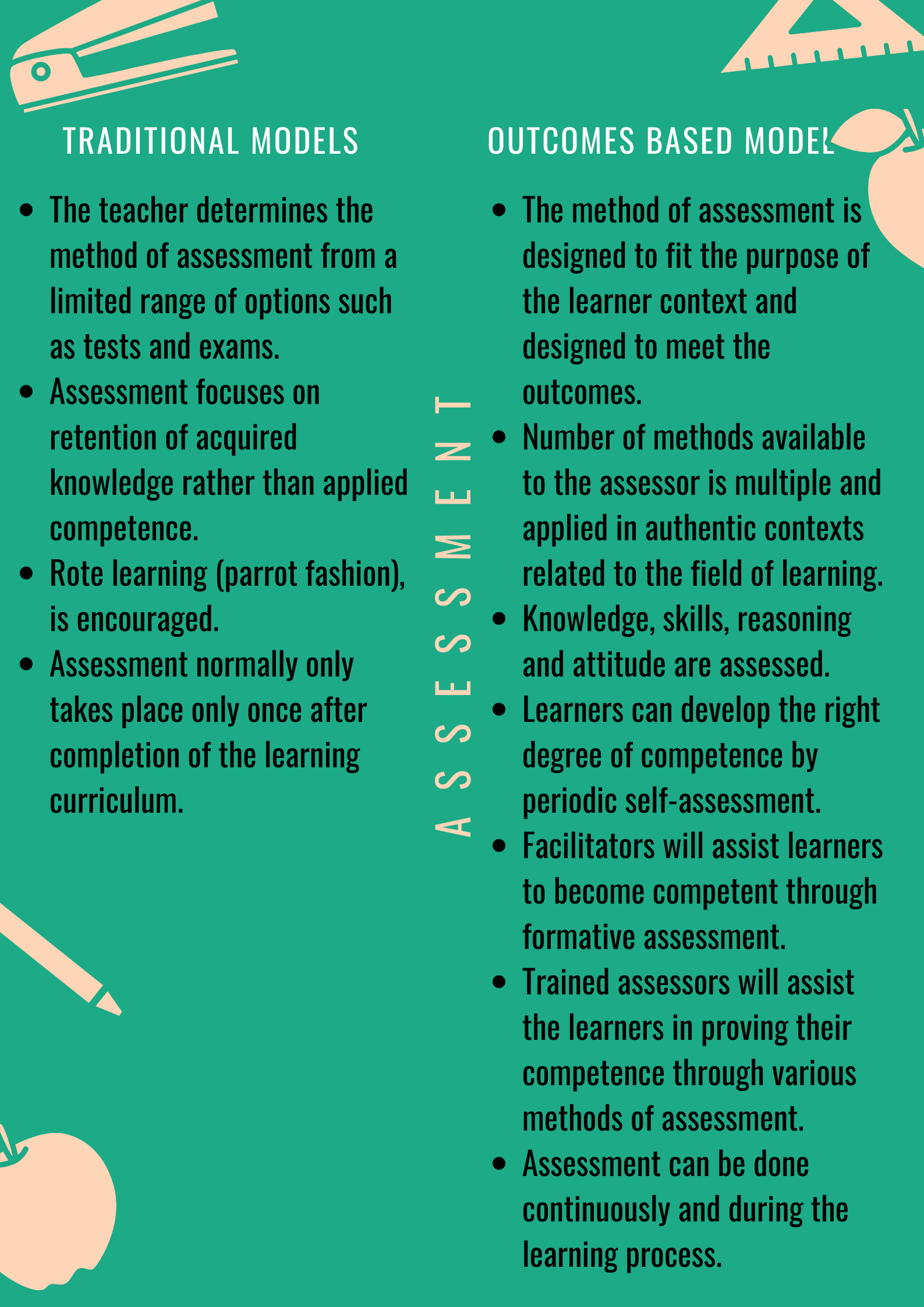Emphasis is on Outputs or End Products
Outcomes-based assessment emphasises the assessment of learner outputs or end products as opposed to lecturer inputs. Knowledge or content of courses are no longer the principal focus but instead the focus is on the application of that knowledge and the demonstration of the required skills and values within specific contexts. These outcomes have to be explicit to ensure that learners clearly understand what is being assessed and what is to be achieved.
Outcomes-based assessment is also characterised by criterion as opposed to norm referencing.
Outcomes-Based Assessment is Criterion Referenced
There has been a complete shift away from the tendency to use a normal curve as the basis for making decisions about individual performance. In contrast to norm referenced testing which is designed for the purpose of comparing learners with one another, criterion referenced assessment is a form of assessment in which judgements are made about learners by measuring their work against set criteria that are independent of the work of other learners. Even if grades are given, learners’ achievements are graded in terms of whether they have satisfied the criteria for assessment.
Criteria are specified in terms of the outcomes set for a course. By putting in time and effort at the beginning of a course, reflecting on and specifying criteria and communicating these clearly to learners, one is in a better position to facilitate learning by giving learners feedback on the extent to which they have, or have not, met those criteria.
Outcomes-Based Assessment is Continuous
Outcomes-based assessment focuses on using frequent and varied assessment techniques to guide learners towards achieving the outcomes set for a course. In contrast to continual assessment in which one merely assesses repeatedly, continuous assessment makes use of a variety of assessment practices during a course or module with the intention of understanding where the learner is. Feedback from assessment enables the lecturer involved to provide as much guidance to learners as possible. This feedback guides learners on their strengths and weaknesses and advises them on how to progress. This kind of assessment need not be formal. Its intention is to inform the learners on the success of their learning so far.
Outcomes-Based Assessment is Used for Formative and Summative Purposes
Outcomes-based assessment makes use of both formative and summative assessment. Formative assessment is used to chart the learner’s progress as he/she works towards achieving the specific outcomes to become competent. If learners have not met the criteria, they would not be competent yet and the onus would be on the assessor to specify what learners have to do in order to meet the criteria and become competent. Summative assessment is formal assessment that is administered at the end of a learning programme. Judgements are made with reference to the criteria set for the assessment tasks.
Lecturer Broadcast: Click here to view an explanation about formative and summative assessments.
Click here to view a video that compares formative and summative assessments.
Outcomes-Based Assessment Is Concerned with Issues Of Reliability And Fairness
Traditionally, reliability refers to consistency of measurement. Outcomes-based assessment is conducive to reliability in those specific outcomes and criteria, and is the basis upon which assessment is planned and administered. These are constant, regardless of who is assessing and who is being assessed. Laying down these specifications makes it necessary for the assessor to use them as a guide in planning, developing, and administering assessment. Because they are specific, known, and clearly understood by all, they act as an built-in mechanisms against assessor inconsistency and assist with the transparency of assessment and description of standards.
Outcomes-Based Assessment Practices Are Valid
Assessment methods and criteria have to match what is to be assessed. Judgements, or results showing measurement outside of what is stated, are viewed as invalid. For example, the use of correct grammar is often used as a criterion when assessing assignments. If this criterion was not mentioned (i.e. was not stated either in the outcomes or prior learning required) it would not be valid to take this factor into account when assessing learner assignments. Many of us may have consciously or unconsciously “marked down” a learner’s assignment due to his or her incorrect use of grammar. It would be invalid to reward or punish a learner for this if it was not specified as a criterion. It would also be unfair.
Outcomes-Based Assessment Includes Integrated Assessment
The purpose of integrated assessment is to provide evidence that the purposes of a course/module as a whole have been achieved. It makes use of a range of formative and summative assessment methods to enable the learner to demonstrate applied competence. Integrated assessment incorporates foundation as well as practical and reflective competences while attempting to bring the overall purpose of the qualification under scrutiny. Learners should be provided with a variety of contexts in which to display their knowledge since a once–off written examination does not provide for the assessment skills that are not suited to that mode of assessment.
Outcomes-Based Assessment Is Aligned with Other Aspects Of The System
Educators increasingly recognise that the major elements of an education system must work together to help learners achieve higher levels of understanding. Outcomes set for each component of the course need to be aligned with the purposes and outcomes for the whole qualification. The methods of teaching and assessing that course must also be aligned with these outcomes. The following diagram attempts to illustrate these concepts:
Understanding Assessment Methods Related to Different Types of Education Philosophies

